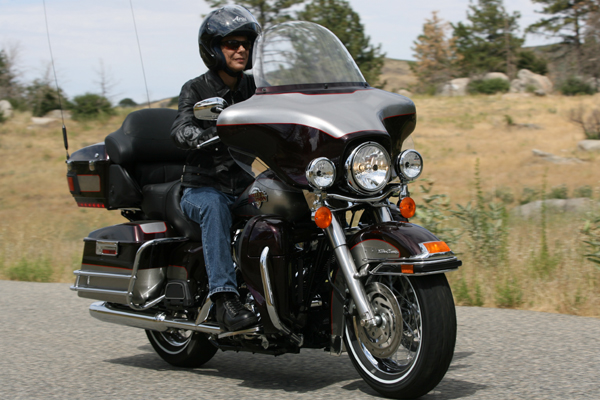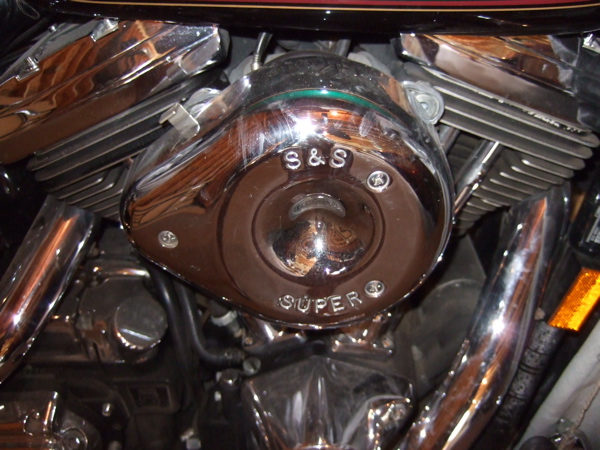Sometimes it is difficult to participate in a technical conversation with others who seem more versed in motorcycle terminology. For those of you who may, on occasion, feel this way, this article was written for you.
Below you will find what I refer to as the basics in motorcycle terminology. I suggest that you browse through your service manual and read the basics so you have a good understanding of your motorcycle and how it works.
1. Carburetor vs. Fuel Injection?
A carburetor is the fuel system component that meters the fuel and air and supplies the proper amounts to the engine. To obtain proper amounts of fuel and air, a technician analyzes specific components like the spark plugs, and based on fixed parameters, alters the mixture of the fuel and air to obtain the correct amounts to the engine.

Alterations to the mixture of air and fuel on a carburetor engine are done manually and are set for a certain environment and altitude. Thats why, for example, when riding a motorcycle with a carbureted engine at high altitudes the motorcycle sputters and sounds like its choking for air. Air is thinner at high altitudes and the mixture of air and fuel set for, say, sea level is not the same amount thats required at elevations of 9,000 feet and higher. The bike is literally choking for more air. If you know youre going to do a fair amount of riding at higher elevations, its smart to get your carburetor re-jetted (air/fuel mixture altered) for those conditions.

Fuel injection meters the fuel and air intake by various sensors that tell an onboard computer how much and when to deliver fuel based on throttle position, engine temperature, crank position, exhaust emissions, etc. Final measurements are decided by the computer, which uses pre-programmed parameters.
2. Drum Brake vs. Disc Brake
Brakes are used as friction devices to slow a vehicle. Both types of brakes provide a mechanical clamping device to slow a spinning wheel on an axis. However, drum brakes use an equal outer pressure on two sides of a bowl shaped surface (the drum) that is connected and spinning with the wheel. This outward pressure is ultimately “resisted to” by the momentum of the forward weight of the spinning wheel, which slows down the motorcycle. Drum brakes arent used as much as disc brakes on modern motorcycles because they can be less efficient than disc brakes. Drum brakes are prone to overheating and more wear and tear than disc brakes. However, you still may see some motorcycles using a disc in the front and a drum in the rear.

Disc brakes use an equal inner pressure on a disc that is directly bolted to a hub and has a smaller contact surface, concentrating on stopping the hub, which is closer to the axle. The axle is the place where the forward motion comes from.

3. Chain Drive vs. Belt Drive
Both types transfer power from a transmission sprocket to a wheel sprocket with a tooth/bar set up. Chain drive has its good points as it is stronger (metal composition) thinner, lighter (comparing two sprockets and a chain, to a belt and two pulleys) and easier to change. The negative side is that chains are messy as they need lubrication regularly; theyre noisy and need adjustment more often.
Belt drive units typically use a Kevlar or rubber belt. No lubrication is needed so it is cleaner. Adjustments are needed at fewer intervals and when adjusted correctly there is no noise at all. The negative side to a belt is that it requires more time to change and there is no roadside fixing should it break.
There is one more type of drive that is referred to as shaft drive. This drive is serviced more like a car with oil and lubricants as it has a drive shaft and u-joints, although not much maintenance is required. A shaft drive is heavier than a chain or belt so its not used in sportbike applications where weight is a factor. Shaft drives are commonly found on touring motorcycles.
4. What is the charging system?
The charging system is the electrical system that operates while the motorcycle is running replacing the current that the battery loses while starting the engine and operating all of the electrical devices. The factory determines the needed voltage for every model, so any extra add-ons that do not come equipped with your stock motorcycle will drain your battery faster than normal.
5. Compression check. Why do it?
This is a test that is performed on your motor with a compression gauge set. The test indicates the sealing effectiveness of the cylinder, piston, rings, valves and gaskets. Normally this test is done for one of two reasons: 1) The bike does not run. 2) You notice a loss of power in the performance area.

6.Three things are required to make a motorcycle run. What are they?
a. Fuel
A fuel tank and its delivery system flow the fuel into the combustion chamber. Fuel delivery systems differ by way of carburetor or fuel pump/injection. You can find reference for your system in your factory service manual.
b. Timed Ignition
The ignition is timed to deliver the spark from the coil to the spark plug at the proper time for the power stroke of the engine. This is when the compressed air/fuel mixture from the intake/carburetor is fired in the combustion chamber. This chamber is the small place in the cylinder head where combustion (burning of air/fuel mixture ) takes place.
c. Compression
This is the relationship between the volume in a cylinder at the beginning of the compression stroke (see below) and the volume in a combustion chamber at top dead center (TDC) (see below).
Compression stroke is piston movement from Bottom Dead Center to Top Dead Center that compresses the air/fuel mixture in the cylinder while the intake and exhaust valves are closed.
Bottom Dead Center (BDC): the piston position when the piston is at the bottom of its stroke/travel.
Top Dead Center (TDC): the piston position when the piston is at the top of its stroke/travel.
7. What is a fouled out plug versus a lean plug?
These are both spark plug conditions and can be found by the removal and inspection of plugs. A fouled plug can be visually apparent as it has a black sooty appearance and texture from running too rich (too much fuel in your air/fuel mixture). It can also be less apparent from gasoline residue as a result of direct fuel into the chamber with no spark.

A lean running condition will create a more expensive result if not corrected in a timely manner. When a plug is lean its visual appearance is that of a neon white blistering of the metal contacts. This situation requires more fuel to the air/fuel mixture to burn within the combustion chamber efficiently. Either one of these conditions can cause a motorcycle to run poorly.
8.What is ping?
Ping is an audible noise heard when accelerating at a higher rate, generating from the engine that sounds like a high pitched metal banging. This is normally caused from ignition timing being too far advanced, or from low octane fuel. Too much pinging creates heat and can lead to engine malfunction. This is evident by a lean spark plug.
This is just a tiny part of motorcycle terminology. If you have any specific questions or suggestions, feel free to contact me at vagabondchickie@aol.com, or visit VagabondChoppers.com

Very informative, very helpful! Thank you!
Thank you for these informative explanations. I now know the visual difference between a drum and a disk brake.
Thanks for posting this. Just helps me keep informed on all aspects of cycling. I need to learn everything! Love the site.
Thank you for posting this information. Nothing frustrates me more than when someone can't take care of their own bike! Then I have to remember that I've been riding for 37 years and was taught at a young age how to fix things. But for those who did not have someone guide them through the mechanical side of things, articles like this one can be very helpful. At the very least it may help someone understand that you just don't throw gas in them and take off!
I am glad I found your site as all the information here is very helpful and easy to understand. Very informative. Thanks!
YES!! This is the kind of article that makes me glad I signed up for the newsletter.
Fantastic overview of the basics. Thanks for simplifying, providing a place to start learning more!
I read this article twice. It is very informative to someone who has no mechanical aptitude at all. Thanks.
Wow. Great article! I just learned about compression and timing the hard way. My H-D 2008 1200 Low (with 48.5 miles on it, yes 48 1/2 not 485) bent a valve in the front cylinder. I have yet to find out from the H-D tech why this happened and which valve it was. I do know you can't ride a bike with only one jug running correctly — especially not all the way to Laconia, which is where I was headed.
This unfortunate situation happened last Friday. Never ever had anything rotten happen on Friday the 13th until last week. Just happy it broke at home, and not while riding up Mount Washington! (Isis is in the shop, prognosis good, parts should arrive by the end of the week.)
Fantastic article! Now that I have decided to branch out into touring on my bike, it is essential than I learn the basics. This article is a great start and I hope there will be many more like it. Thank you!
Thank you! It's great info and very
helpful. I printed the article for future
reference (SMILE).